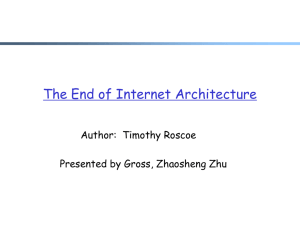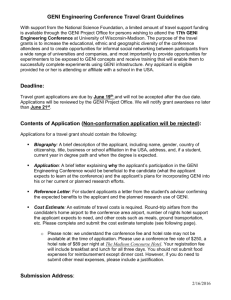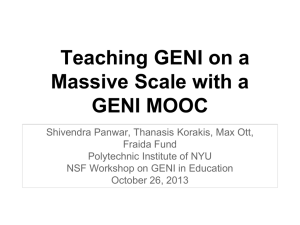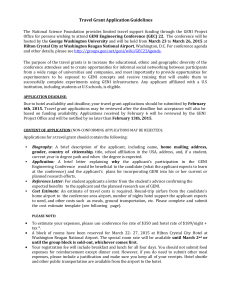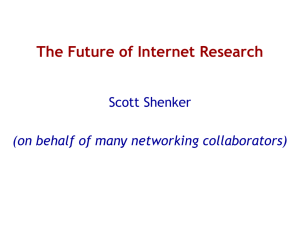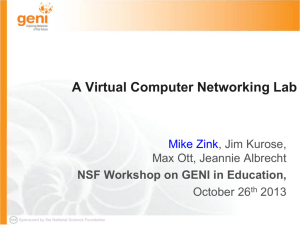GENI: Global Environment for Network Innovations
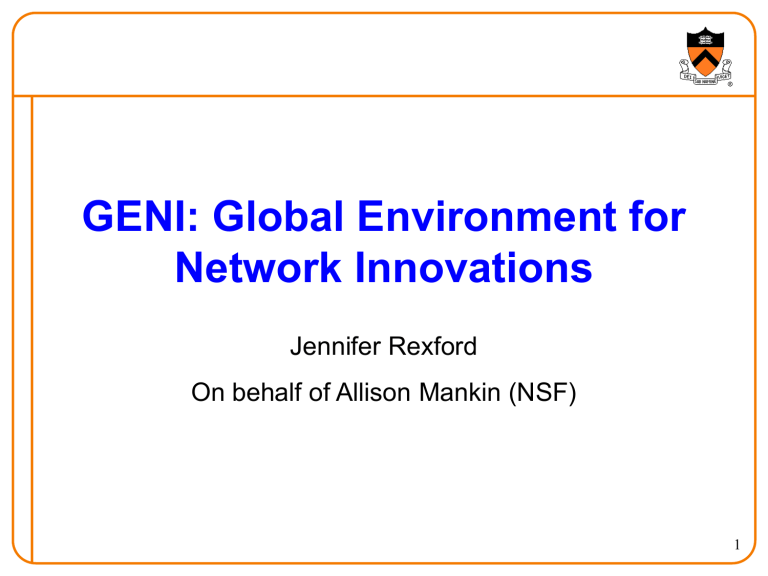
GENI: Global Environment for
Network Innovations
Jennifer Rexford
On behalf of Allison Mankin (NSF)
1
Is the Internet broken?
• It is great at what it does.
–Everyone should be proud of this.
–All sorts of things can be built on top of it.
• But…
–Security is weak and not getting better.
–Availability continues to be a challenge.
–It is hard to manage and getting harder.
–It does not handle mobility well.
–A long list, once you start…
2
FIND: Future Internet Design
• NSF research initiative
– Requirements for global network of 10-15 years out?
– Re-conceive the network, if we could design from scratch?
• Conceive the future, by letting go of the present:
– This is not change for the sake of change
– Rather, it is a chance to free our minds
– Figuring out where to go, and then how to get there
• Perhaps a header format is not the defining piece of a new architecture
– Definition and placement of functionality
– Not just data plane, but also control and management
– And division between end hosts and the network
3
The Importance of Building
• Systems-oriented computer science research needs to build and try out its ideas to be effective
– Paper designs are just idle speculation
– Simulation is only occasionally a substitute
• We need:
– Real implementation
– Real experience
– Real network conditions
– Real users
– To live in the future
4
GENI
• Experimental facility
– MREFC proposal to build a large-scale facility
– Jointly from NSF’s CS directorate, & research community
– We are currently at the “Conceptual Design” stage
– Will eventually require Congressional approval
• Global Environment for Network Innovations
– Prototyping new architectures
– Realistic evaluation
– Controlled evaluation
– Shared facility
– Connecting to real users
– Enabling new services
See http://www.geni.net
5
Three Key Ideas in GENI
• Virtualization
– Multiple architectures on a shared facility
– Amortizes the cost of building the facility
– Enables long-running experiments and services
• Programmable
– Enable prototyping and evaluation of new architectures
– Enable a revisiting of today’s “layers”
• Opt-in on a per-user / per-application basis
– Attract real users
• Demand drives deployment / adoption
– Connect to the Internet
• To reach users, and to connect to existing services
6
Slices
7
Slices
8
User Opt-in
Client
Proxy
Server
9
Realizing the Ideas
• Slices embedded in a substrate of resources
– Physical network substrate
• Expandable collection of building block components
• Nodes / links / subnets
– Software management framework
• Knits building blocks together into a coherent facility
• Embeds slices in the physical substrate
• Builds on ideas in past systems
– PlanetLab, Emulab, ORBIT, X-Bone, …
10
Challenges in Realizing the
Goals of GENI
Jennifer Rexford
Princeton University
11
What is the Goal of GENI?
• Network architecture research
–Revisit the definition and placement of function
–For better security, scalability, manageability, …
• Enable evaluation of network architectures
–In a controlled and realistic fashion
–With long-running deployment studies
–With real user traffic, and real network conditions
• Challenges
–Using GENI effectively
–Designing, building, and running GENI
12
Challenge #1: Theory and Systems
• “Clean-slate” network architecture research
– Creative ideas unconstrained by existing artifacts
– A chance for theory to drive future architectures
– … and to finally have a “science of design” for networks
• Emphasis on deployment and experimentation
– Evaluation of prototypes under realistic conditions
– A chance for systems work to drive future architectures
– … and to finally have a “tech transfer” path
• Can we connect good theory with good systems?
– Turning distributed algorithms into network protocols
13
Challenge #2: Revisiting the Layers
• Today’s architecture is a collection of layers
– Application, transport, network, link, …
– Organizing principle for networking textbooks
– Fragmentation of the research community
• Revisiting the division of functionality is hard
– Inherently a “cross-layer” research problem
– Benefits from expertise across multiple layers
• Can we, as researchers, cross the layer boundaries?
– And create tools for decomposing a system, and analyzing the resulting complexity?
14
Example Research Questions
• Traffic management
– Today: congestion control (end hosts), routing protocols
(routers), and traffic engineering (network operators)
– Tomorrow: discovering the right division of labor
• Scalable routing
– Today: exciting theoretical results in compact routing
– Tomorrow: turning those into network protocols
• Mobile hosts
– Today: network backbone ignores host mobility
– Tomorrow: wired-network support for mobile hosts
• Adversarial settings
– Today: protocols based on trust in the participants
– Tomorrow: protocols that are robust to greed and malice
15
These are Hard Problems
• Interdisciplinary research is hard
– Theory and systems
– Crossing, and revisiting, the layers
• But these issues are at the core of networking
– We must grapple with them
– Not just to “fix the Internet”, but also as scholars
• To move networking from a problem domain to an intellectual discipline
• To teach our students better
• GENI is an enabler, but not a solution
16
Building Networks like GENI
• Programmable virtual networks
– A distributed, programmable experimental facility
– Shared on a small timescale, carrying real user traffic
• Theoretical challenges
– Embedding a virtual topology in a shared substrate
– Coordinating resource allocation across a federation
• Platform for investigating the challenges
– VINI: VIrtual Network Infrastructure
– http://www.cs.princeton.edu/~jrex/virtual.html
• Maybe net virtualization is itself an architecture
– No “One Architecture to Rule Them All”…
17
